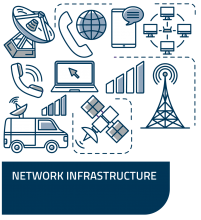Jeni Panhorst graduated summa cum laude with a bachelor's degree in computer engineering and a minor in artificial intelligence from Case Western Reserve University. She's currently a Vice President in the Data Platforms Group and the General Manager of the Network & Edge Platforms Division with Intel Corporation and shared advice for those looking to enter the field of technology. Jeni recently celebrated her 20th anniversary with Intel.
The Network Business of Intel
I lead the Network & Edge Platforms Division at Intel. My group drives the product portfolio for Intel’s network and edge infrastructure businesses. It's a super exciting place to be because it's a high growth area for Intel and we've got a lot of work to do.
When we talk about “network infrastructure,” it's a lot of equipment that most of us don’t see in our daily lives—yet it empowers us to communicate. It enables our cell phones, PCs and other devices to communicate with each other and back to the cloud—so basically, as we like to put it, it’s everything you can't see but you can't live without.
We’re focused on building network infrastructure within telecommunications and data center networks. We work with equipment manufacturers such as Ericsson, Cisco and Dell, and also with a broad ecosystem of companies, including networking software vendors, who in turn collectively build solutions for communications service providers, enterprises and cloud service providers all around the world.
Growing Trends Within Network Infrastructure
We're really focused on two key trends: 5G and edge computing.
5G
Today, most of our mobile phones run on 4G LTE wireless technology and we're now entering the era of 5G, which is the fifth generation of networking. 5G networks are beginning to really turn on and ramp up in 2020.
What does that mean?
The eventual promise of 5G is significant improvement (i.e., order of magnitude improvement) in bandwidth, in latency, in coverage and in connectivity for all of your devices—whether it's your smartphone or an internet of things (IoT) device or any other devices that connect.
When you look at the type of traffic that's flowing over these devices and flowing over these networks each day, video is a HUGE driver. In fact, it’s roughly 75% of all internet traffic. And with live video becoming increasingly important, along with two-way video and cloud gaming, a lot more user interactivity will continue to warrant stronger networks.
Given the promise of 5G and its inherent reliability, it will start to enable a lot of new use cases like smart transportation, smart cities, smart energy and smart agriculture. And with the change happening in our post-Covid world, we expect to see acceleration in areas like distance learning and remote healthcare. It's really the promise of bringing all of those exciting use cases to both consumers and businesses worldwide.
And this goes hand-in-hand with the other trend, which is edge computing….
Edge computing
Edge computing is the concept of distributing and cloudifying compute closer to the actual data where it can generate the biggest return and value to a business or end user. This can help solve business problems and also open new opportunities such as improving the customer experience, or monetizing data through new services.
Data is growing exponentially and it's just simply not economical to transfer all of that data back to the cloud or back to centralized data centers for processing. It costs a lot of money and very often, in business, you need fast decisions based on that data, and it’s not moving fast enough. Increasingly, computing, including artificial intelligence (AI) and machine learning, will need to move closer to where that data is gathered and where all those devices and things are connected to the network to keep up with demand.
What we’re focusing on as part of our edge computing initiatives is enabling all those use-cases by partnering with those customers and other partners across the ecosystem to build out this capacity for edge computing.
These are a really exciting set of trends to be involved in.
Importance of Soft Skills in the Network Business
There are so many different fields of engineering, and those who are entering the field are working on developing a depth of technical skills that can be utilized. But it’s also important to focus on the soft skill sets that are critical for driving innovation and solving problems that we're hearing about from the industry and from customers.
Problem solving
No matter what kind of engineer you are, two of the best tools that you have in your toolkit are problem-solving skills and a mindset to experiment and learn, fail and learn, then fail again until find an answer to the problem at-hand.
Growth mindset
Be willing to adapt your perspective based on what you're learning. This goes hand in-hand with good listening skills.
Any business or organization that you work within is comprised of people. Each person brings their own multidimensional perspectives to any situation, so the more you seek to listen and to understand their backgrounds, views and motivations, the more quickly you’ll find common ground to tackle whatever task you have at hand.
Being a Woman in the Network Business
With my educational background in computer engineering starting out in high school and then in college, it really got me used to being in an environment where I was the only woman in the room. And early in my career, when I first became a team lead, I led a team that was comprised mainly of men who were 10 to 20 years my senior.
I had tremendous support from my boss and members of the team. Still, it was very clear that I was different. I actually didn't have a female manager or direct female peer until 15 years into my career.
Despite all of that, I really don't feel like I've ever been a victim of overt discrimination, but I also joke that sometimes I'm oblivious to things that are happening to me. Especially early in my career, I didn't always notice the microinequities that would occur. Over time, I’ve become more aware when women or underrepresented minorities are interrupted, or have seen where people will shake the man’s hand before yours—as they assume that person is in charge. I believe we have an obligation to serve as advocates and allies for those who aren’t being heard – be aware when these situations occur and be intentional about correcting them.
Example: When someone gets interrupted, I ask an intentional question to draw that person back in and make sure their voice is heard, or to ensure they get credit for an idea.
Other times, when a correction can’t be made in the moment, as a leader that’s behavior that I’ll work on with someone offline. In these cases, we’ll have a conversation about how their actions and/or words might be impacting someone else.
I’m proud to work for a company that has been an industry leader in diversity and inclusion. We’ve established Inclusion as a core tenet of our company values and corporate responsibility goals and strategy. As we look to 2030, we strive to advance diversity and inclusion across our global workforce and industry with goals to increase women in technical roles to 40% and double the number of women and underrepresented minorities in senior leadership. We will also collaborate with our industry to create and implement a Global Inclusion Index that will provide common definitions and data to clearly identify root causes and actions needed to collectively advance progress and build the future pipeline of talent. I’m glad to be part of an organization focused on ensuring all voices are heard, and people are empowered to do their best work – it makes sense for the people, and it makes sense for the business. We’ve made a tremendous amount of progress, but there is so much more to do.
“What I find is that engineers often make the best businesspeople because you need excellent problem-solving skills in order to solve business problems.”
– Jeni Panhorst, Vice President in the Data Platforms Group and the General Manager of Network & Edge Platforms Division with Intel Corporation
Go-to Resources
I encourage everyone to remain a life-long learner and stay attuned with knowing what’s happening in business.
Keep an eye on business resources like The Wall Street Journal and Business Insider, sign up for emails from Harvard Business Review that feature stories and case studies of great research they’ve conducted in the business school.
There are so many resources out there today, and I find it valuable to source a wide range of viewpoints. Whether it's a publication like Wired, which is a little bit more “pop-tech” or other publications like EE times, I find resources like these valuable. And in networking, I focus on specific publications and websites such as Fierce Wireless and TelecomTV which help me keep abreast of industry developments.
Podcasts are another great tool I use to learn. I love learning from founders, leaders and experts in the field and learning from interviews. I listen to How I Built This from NPR, Work Life from TED, HBR IdeaCast from Harvard Business Review, and many others.
***
To listen to the podcast interview CWRU WIT conducted with Jeni, click here.




